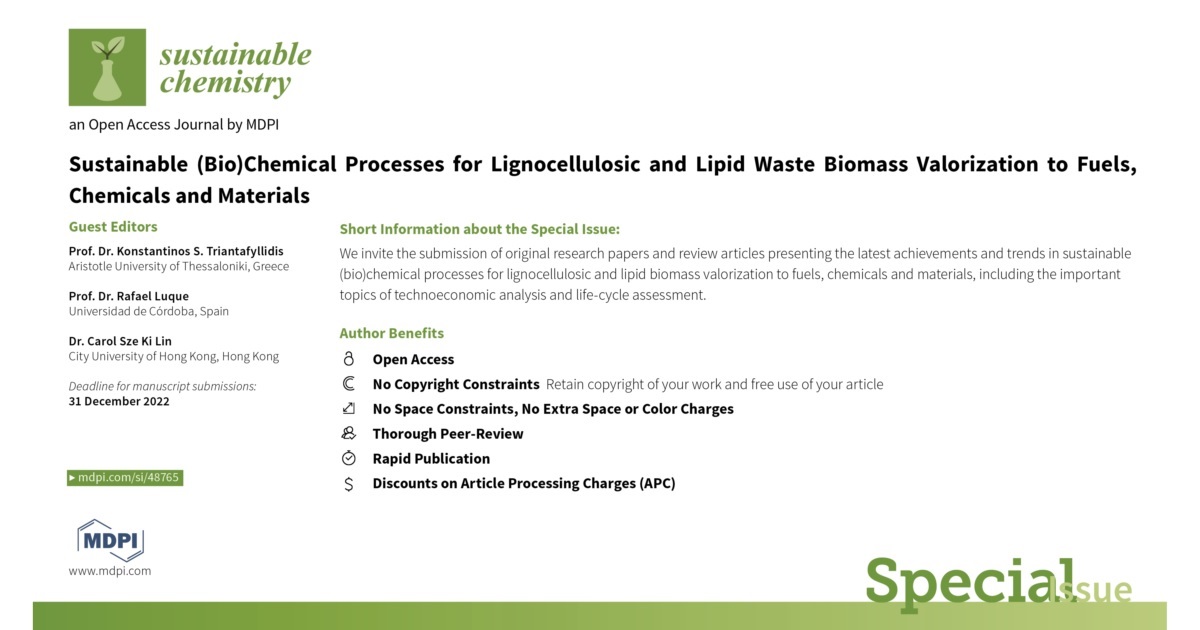Sustainable (Bio)Chemical Processes for Lignocellulosic and Lipid Waste Biomass Valorization to Fuels, Chemicals and Materials
A special issue of Sustainable Chemistry (ISSN 2673-4079).
Deadline for manuscript submissions: closed (31 December 2022) | Viewed by 22469

Special Issue Editors
Interests: green chemistry; heterogeneous catalysis; synthesis and characterization of nanostructured materials; thermochemical and catalytic processes for biomass valorisation; biobased polymers and nanocomposites
Special Issues, Collections and Topics in MDPI journals
Interests: green chemistry; biomass valorization; heterogeneous catalysis; nanomaterial design
Special Issues, Collections and Topics in MDPI journals
Interests: circular economy; green and sustainable chemistry; metabolic engineering of microorganisms for fermentative production of biobased products; waste and biomass valorisation
Special Issue Information
Dear Colleague,
The projected depletion of fossil resources (petroleum and coal) and the environmental pollution caused by their intensive use, in the form of fuels/energy, toxic chemicals and nonbiodegradable polymers, have spurred the generation of the “bioeconomy” and “circular economy” concepts, which will comprise the main pillars of our society in the years to come. To this end, the utilization of natural renewable resources, such as lignocellulosic and lipid biomass, preferably in the form of wastes, residues and byproducts (e.g., forestry and agricultural wastes, food waste, low quality lipids, vegetable oils used in cooking, industrial organic byproducts, municipal wastes, etc.) toward the production of chemicals, fuels and materials has become an emerging area of basic and applied multidisciplinary research. Despite the significant advances already achieved in the last 20 years, more sustainable technologies and zero-waste integrated biorefinery approaches still need to be developed. Within this context, we invite the submission of original research papers and review articles presenting the latest achievements and trends in sustainable (bio)chemical processes for lignocellulosic and lipid biomass valorization to fuels, chemicals and materials, including the important topics of technoeconomic analysis and life-cycle assessment.
Prof. Konstantinos S. Triantafyllidis
Prof. Rafael Luque
Dr. Carol Sze Ki Lin
Guest Editors
Manuscript Submission Information
Manuscripts should be submitted online at www.mdpi.com by registering and logging in to this website. Once you are registered, click here to go to the submission form. Manuscripts can be submitted until the deadline. All submissions that pass pre-check are peer-reviewed. Accepted papers will be published continuously in the journal (as soon as accepted) and will be listed together on the special issue website. Research articles, review articles as well as short communications are invited. For planned papers, a title and short abstract (about 100 words) can be sent to the Editorial Office for announcement on this website.
Submitted manuscripts should not have been published previously, nor be under consideration for publication elsewhere (except conference proceedings papers). All manuscripts are thoroughly refereed through a single-blind peer-review process. A guide for authors and other relevant information for submission of manuscripts is available on the Instructions for Authors page. Sustainable Chemistry is an international peer-reviewed open access quarterly journal published by MDPI.
Please visit the Instructions for Authors page before submitting a manuscript. The Article Processing Charge (APC) for publication in this open access journal is 1000 CHF (Swiss Francs). Submitted papers should be well formatted and use good English. Authors may use MDPI's English editing service prior to publication or during author revisions.
Keywords
- Lignocellulosic biomass
- Lipid biomass
- Agricultural and forestry wastes
- Industrial residues and byproducts
- Food waste
- Hazardous wastes
- Biobased platform chemicals
- Biobased polymers and composites,
- Biofuels
- Biochar
- Biobased food additives
- Thermochemical and (bio)catalytic conversion
- Advanced analytical methods
- Scale-up of biomass valorization processes
- Technoeconomic analysis
- LCA
- Green chemistry and chemical technology
- Circular (bio)economy
Benefits of Publishing in a Special Issue
- Ease of navigation: Grouping papers by topic helps scholars navigate broad scope journals more efficiently.
- Greater discoverability: Special Issues support the reach and impact of scientific research. Articles in Special Issues are more discoverable and cited more frequently.
- Expansion of research network: Special Issues facilitate connections among authors, fostering scientific collaborations.
- External promotion: Articles in Special Issues are often promoted through the journal's social media, increasing their visibility.
- Reprint: MDPI Books provides the opportunity to republish successful Special Issues in book format, both online and in print.
Further information on MDPI's Special Issue policies can be found here.







